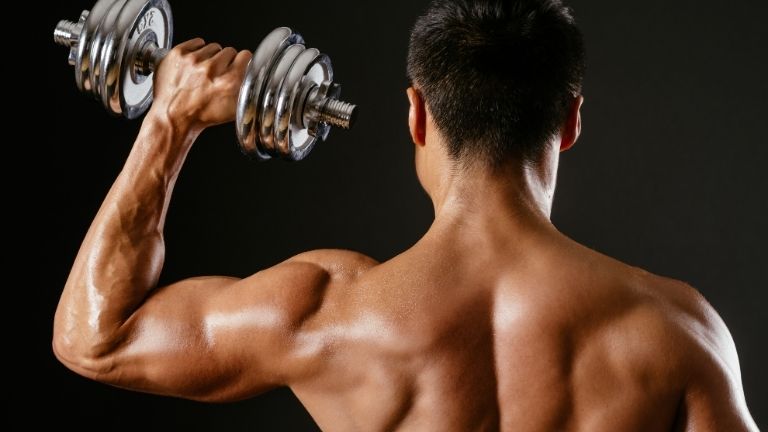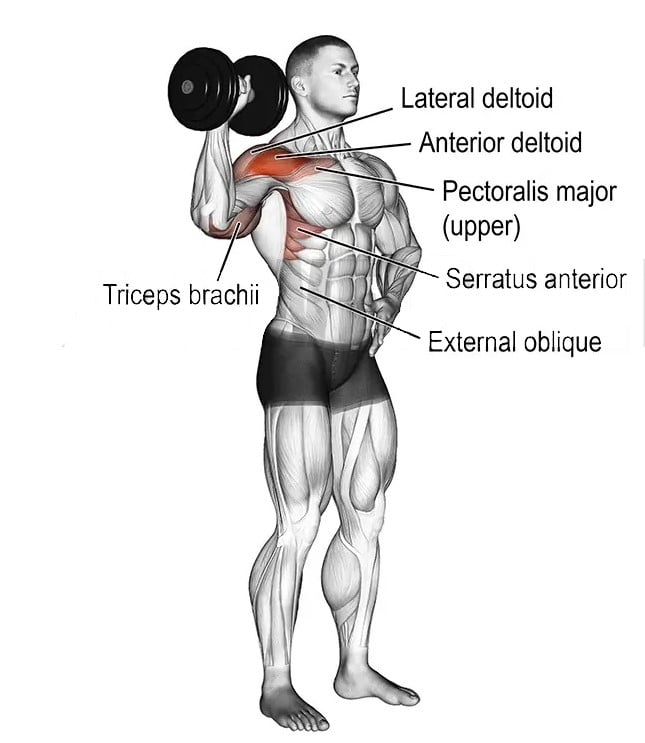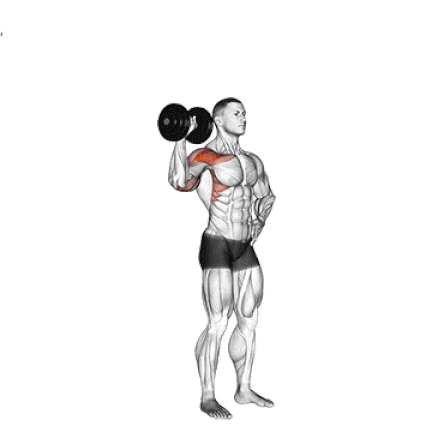The single-arm shoulder press is a solid, compound movement that works the deltoid (front and lateral delt), the triceps, and all the supporting muscles throughout the body.
The single-arm dumbbell shoulder press is a unilateral exercise that increases shoulder strength, stability, and symmetry. Doing the exercise with one arm at a time will work your core throughout the range of motion.
You can do it in so many ways. But, we’ll focus on the standing dumbbell overhead press, as it’s a very popular yet effective variation.

Single Arm Shoulder Press Muscles Worked
- Primary: Deltoids (anterior, lateral, posterior)
- Secondary: Triceps brachii, Upper pectoralis major, and Serratus anterior.
- Stabilization: Rotator cuff muscles (supraspinatus, infraspinatus, teres minor, subscapularis), Trapezius, and Core muscles (Obliques and Rectus abdominis.)

How To Do One Arm Dumbbell Shoulder Press
- First, grab a dumbbell that feels challenging but still manageable. Hold a dumbbell in your one hand.
- Now, stand tall. Your feet should be about shoulder-width apart, and here’s the key – engage that core like you’re bracing for impact. This is super important to keep you steady, especially since you’re only pressing with one arm. It helps avoid that arch in your lower back.
- When you’re ready, press the dumbbell straight up. You want to push it right overhead until your arm is fully extended.
- Don’t rush this part – take your time and focus on feeling your shoulder doing the work. Oh, and ensure you’re not shrugging your shoulder towards your ear.
- Once you’re at the top, bring it back down nice and controlled to your starting position.
- Switch sides after finishing your reps on one arm, and repeat the process on the other.
Want to take your gains to the next level? Discover your daily calorie needs with our free TDEE calculator
Tips and Form
- Keep your torso still, your back straight, and your elbow slightly bent.
- Don’t allow your torso to sway to one side or the other as you press the weight overhead.
- Keep a controlled motion and avoid jerky movements.
- Always use weights that you can handle comfortably.
- A lot of people mess this up by pressing in a straight line. Instead, aim for a 45-degree angle, which is safer and helps you press more effectively.
- Don’t just toss the weight up halfway. Go for full extension at the top and bring the weight back down with control. If you have shoulder issues, adjust the range of motion to your comfort, but don’t rush through the reps.
- If you want to keep more tension through the side delts, use a slightly slower eccentric than normal.
- Always use the longest range of motion possible and control the dumbbells throughout the set.
- It is best to work on the weaker arm first. This is most often the left arm.

One Arm Shoulder Press Benefits
- This single-arm exercise isolates each shoulder and focuses on building strength and size in the deltoids.
- Working one shoulder at a time requires more control and stabilization from smaller muscle groups, such as the rotator cuff, which can improve shoulder joint stability.
- To do a one-arm press correctly, your core muscles must work hard to keep your body stable and prevent leaning or turning. This enhanced core activation helps build a stronger midsection.
- It helps you find and prevent muscle imbalances or weaknesses between your left and right shoulders.
- The one-arm version provides variety if you’re used to two-arm overhead pressing movements. It gives your shoulders a new stimulus to adapt to.

Manish is a NASM-certified fitness and nutrition coach with over 10 years of experience in weight lifting and fat loss fitness coaching. He specializes in gym-based training and has a lot of knowledge about exercise, lifting technique, biomechanics, and more.
Through “Fit Life Regime,” he generously shares the insights he’s gained over a decade in the field. His goal is to equip others with the knowledge to start their own fitness journey.
